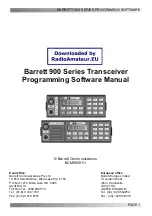
P25 - SRM9022 RADIO – OPERATING INSTRUCTIONS
©
TMC Radio 2007
page 55
TNM-U-E-0055 Issue 2.1a
7.4 C
OMPLIANCE WITH
RF E
NERGY
E
XPOSURE
G
UIDELINES
(U
NITED
STATES
AND
C
ANADA
)
RF ENERGY EXPOSURE AWARENESS AND CONTROL INFORMATION AND OPERATIONAL
INSTRUCTIONS FOR FCC OCCUPATIONAL USE REQUIREMENTS.
Before using your TMC Radio mobile two-way radio, read this important RF energy awareness and
control information and operational instructions to ensure compliance with the FCC’s RF exposure
guidelines.
NOTICE: This radio is intended for use in Occupational/ controlled conditions in a mobile
application where users have full knowledge of their exposure and can exercise control over
their exposure to meet FCC limits. This radio device is NOT authorised for general population,
consumer, or any other use.
This two-way radio uses electromagnetic energy in the radio frequency (RF) spectrum to provide
communications between two or more users over a distance. It uses radio frequency (RF) energy or
radio waves to send and receive calls. RF energy is one form of electromagnetic energy. Other forms
include, but are not limited to, electric power, sunlight and x-rays. RF energy, however, should not be
confused with these other forms of electromagnetic energy, which when used improperly can cause
biological damage. Very high levels of x-rays, for example, can damage tissues and genetic material.
Experts in science, engineering, medicine, health and industry work with organizations to develop
standards for exposure to RF energy. These standards provide recommended levels of RF exposure
for both workers and the general public. These recommended RF exposure levels include substantial
margins of protection. All two-way radios marketed is North America are designed, manufactured and
tested to ensure they meet government established RF exposure levels. In addition, manufacturers
also recommend specific operating instructions to users of two-way radios. These instructions are
important because they inform users about RF energy exposure and provide simple procedures on
how to control it. Please refer to the following websites for more information on what RF energy
exposure is and how to control your exposure to assure compliance with established RF exposure
limits.
http:l/www.fcc. gov/oet/rfsafety/rf-fags. htm 1
http://www.osha.gov/SLTC/radiofrequencvradiation/index.htmi
Federal Communications Commission Regulations:
The FCC rules require manufacturers to comply with the FCC RF energy exposure limits for mobile
two-way radios before they can be marketed in the U.S. When two-way radios are used as a
consequence of employment, the FCC requires users to be fully aware of and able to control their
exposure to meet occupational requirements. An exposure awareness label is attached to the
equipment directing users to specific awareness information.
Compliance with RF Exposure Standards
Your TMC two-way radio is designed to comply with a number of national and international standards
and guidelines (listed below) regarding human exposure to radio frequency electromagnetic energy.
This radio complies with the IEEE (FCC) and ICNIRP exposure limits for Occupational/ Controlled RF
exposure environment at duty factors of up to 50% talk 50% listen and is authorised by the FCC for
occupational use. In terms of measuring RF energy for compliance with the FCC exposure guidelines,
your radio radiates measurable RF energy only while it is transmitting (during talking), not when it is
receiving (listening) or in standby mode.
Your TMC Radio two-way radio complies with the following RF energy exposure standards and
guidelines:
•
United States Federal Communications Commission, Code of Federal Regulations; 47CFR
part 2 sub-part J




































